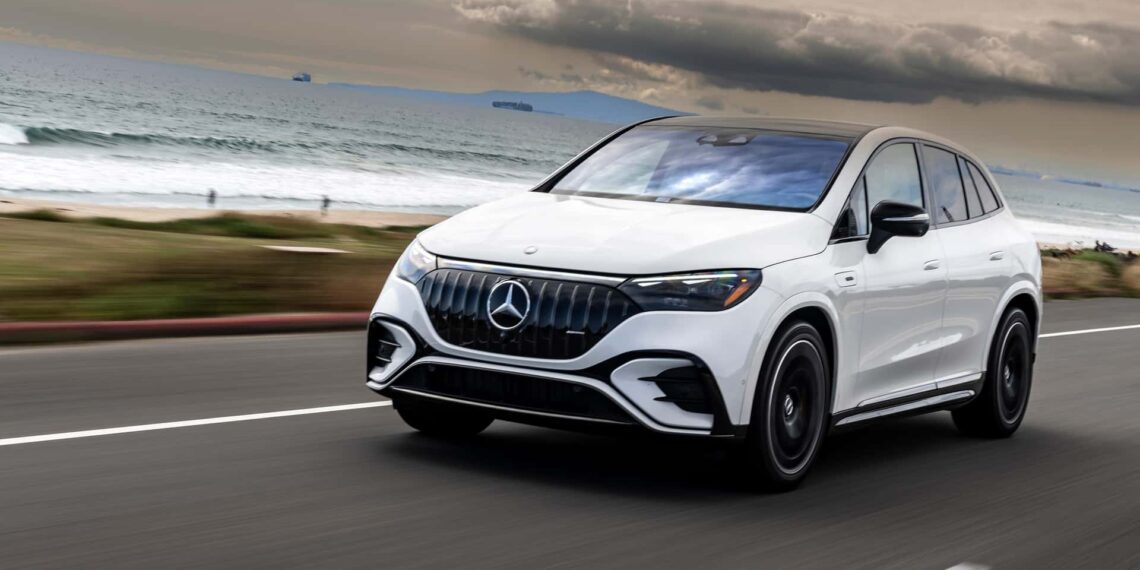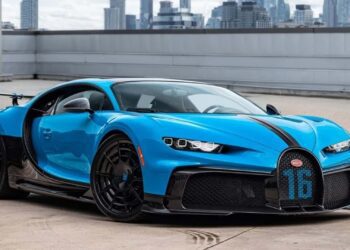Mercedes-AMG has wasted no time rolling out its revamped lineup as it works toward going fully electric by 2030. Starting with the AMG EQS Sedan, the German carmaker showcased that adding an electric motor only highlights what it does best, building opulent machines with serious on-road performance.
The AMG EQE Sedan followed shortly after, and now the carmaker has pulled the cover on its first electric SUV, the 2024 AMG EQE SUV. It’s a case of “same, same, but different,” with the SUV borrowing heavily from its sedan counterpart while adding extra practicality via more interior and cargo space.
However, as the whole brand shifts towards electrification, its products change. And while adding a silent and powerful powertrain suits a six-figure luxury SUV well, the added heft of a battery pack makes the AMG EQE SUV less of a thrilling driver. The question is, does it even matter?

Quick Stats
| Motor | Two Permanently Excited Synchronous Motors |
| Output | 617 Horsepower / 701 Pound-Feet |
| 0-60 MPH | 3.4 Seconds (With Race Start) |
| Weight | 5,930 Pounds |
The high-riding EQE’s aesthetic is almost identical to the sedan’s. It carries over the same aero-focused design, which, although controversial at first, is starting to create a unique identity for the brand’s EQ models as more roll out. Up front, it wears a Panamericana-style “grille” finished in gloss black. Its lower front fascia adds a subtle splitter flanked by air inlets on either side.
Like its sedan siblings, the SUV benefits from short front and rear overhangs, a sloping roofline, and a tall shoulder line. There’s a subtle roof spoiler, a tiny rear window, and a sizable gloss black diffuser that splits the rear bumper. It’s all quite a standard affair that translates well onto a larger body, minus the pseudo-exhaust exits trimmed in chrome.

The AMG EQE SUV looks deceptively large in photos. Proportionally, its 192.1 inches long, 76.4 in wide, and 65.8 in tall with a 119.3-in wheelbase, making it smaller than both a Tesla Model X and BMW iX. Its dimensions are closer to those of a Maserati Grecale, falling on the smaller end of the mid-size SUV segment. That said, it still offers 18.4 cubic feet of cargo space with the rear seats up or 59.2 cu-ft folded.
Although its smooth lines certainly help it from an aerodynamic perspective, there’s a distinct lack of aggression on display. The EQE is more sleek than sporty, lacking the widened arches and aggressive stance of older AMG SUVs. If anything, this design shift is representative of a closer alignment to a luxury aesthetic rather than over-the-top sportiness.

That said, the AMG EQE SUV would wear more muscular bodywork well, especially as it has the power to back it up. Anyone familiar with the AMG EQE Sedan will feel Deja Vu when reading the SUV’s stats as it shares the same two-motor configuration. It develops a combined 617 horsepower and 701 pound-feet of torque. Engage Race Start, however, and those figures boost up to 677 hp and 738 lb-ft momentarily, allowing for a sprint to 60 mph of 3.4 seconds.
A 3.4-second dash is impressive, but more so when considering the EQE’s hefty 5,930-pound curb weight. It weighs nearly 400 lb more than the sedan, but you can hardly tell in a straight line. With Race Start engaged, the EQE rockets off the line, and despite what its claimed stats suggest, it feels even quicker in the real world as its power comes on instantly rather than progressively.
Race Start is part of the AMG Dynamic Plus package, which also raises the SUV’s top speed to 149 mph and includes the AMG Sound Experience, the brand’s collection of acceleration sounds. In practice, they work well once you accept the fact that you’re not replacing the howl of a burbly V8. You’re experiencing something completely different.

On the road, Affalterbach’s electric SUV rides like a proper luxurious cruiser. It’s plush and soaks up road imperfections well, with little road noise entering the cabin. Even in AMG form with larger 21-in wheels and slimmer Michelin Pilot Sport EV tires, the EQE rides impeccably well. Suspension-wise, it features adaptive air struts on all four corners with AMG’s Active Ride Control to keep the body roll in check.
As part of AMG’s Dynamic Select program, you get multiple drive modes, including Slippery, Comfort, Sport, and Sport+. As you move from the least to the most aggressive, the EQE’s power output increases, its responsiveness sharpens, and its suspension stiffens. However, it never gets to the point of being too stiff. Even with everything dialed up, the EQE is still plush.
While that yields comfort benefits on the open road, the EQE suffers in the bends. It may have the power to carry a quick pace on a twisty road, but its body motions aren’t as well controlled. It’s bouncy and leans considerably, reminding you of its added heft, a stark contrast to its surefootedness in a straight line.

Like the rest of the EQ lineup, the EQE’s brake pedal moves depending on the amount of electrical regeneration. As such, it’s never quite where you expect it to be. The result is a braking experience that’s far from smooth. Once you get your foot right, the pedal travel is short, and the response is stiff, more akin to something you’d find in a sports car.
Overall, you get the sense that although the EQE has the goods to go up a twisty road at pace, it doesn’t want to. Take its steering, for example, which is weighted nicely, but is slow and lacks feedback. It’s a joy around town but slightly too luxury-oriented for a spirited drive.
Although the EQE isn’t quite as thrilling to drive as I hoped it would be, I’m not sure that aspect of its personality matters as much as it once did. Over the last decade, performance SUVs have only gotten softer and more luxurious, representing that while an athletic SUV sounds great in theory, buyers actually want something quick but practical and comfortable as well, areas where the EQE excels.

While Mercedes-AMG has yet to publish official range figures for the EQE SUV, it shares the same 90.6-kWh lithium-ion battery pack as the sedan, which has an EPA-estimated range of 225 miles. The big differentiator is weight. The EQE SUV is nearly 400 lb heavier than the sedan, making its range figure most likely less than its counterpart. It’ll charge at 170 kW, recuperating around 100 miles in 15 minutes.
To ensure the quickest possible charge time, the EQE utilizes its navigation system to determine when you’re approaching a charging station and precondition the battery by heating or cooling it depending on what’s needed.

Inside, you get the same level of quality and finish you’d expect from a six-figure Mercedes-AMG product, which is to say it’s just as good if not better than its competitors. The cabin’s centerpiece is the massive hyperscreen, which combines a digital instrument cluster, a central infotainment display, and a passenger screen. Like the EQE’s styling, the hyperscreen proved controversial at launch but has begun aging well.
What sets it apart is how well it blends the graphics and systems of all three screens into a seamless unit. So much so that despite offering smartphone systems like Apple CarPlay or Android Auto, I avoid using them. The native MBUX system is excellently laid out, with each control where you’d expect it to be.

U.S. models get the hyperscreen and Nappa leather as standard, the latter covering the seats and the flat-bottom steering wheel. There is very little use of plastic throughout the cabin. Like in previous AMGs, everything you interact with feels like a quality item. There’s a solidness present in the EQE that’s lacking in competing EVs, a further nod to its luxury focus.
The added benefit of opting for the SUV is the extra light that comes in through its massive windows. Combined with the glass roof and a light-colored interior, the EQE is elegant and airy, making it feel larger inside despite being proportionally smaller than some of its direct competitors. With the added interior and cargo space, the EQE is the right size for most people and a wonderful place to cover miles.
Pricing has yet to be announced, although the 2023 Mercedes-AMG EQE 4Matic+ starts at $108,050, including a $1,150 destination charge. As such, expect its high-riding counterpart to start at around $110,000, with fully-optioned examples coming in closer to $120,000.

AMG’s first electric SUV is exactly what I expected it to be. It’s a missile in a straight line, impeccably well-built, filled to the brim with tech, and supremely comfortable in most situations. For those looking for a high-power luxury commuter, it’s hard to fault. This is where it excels.
Take it on a back road, and things change. Its 5,930-lb curb weight becomes an issue as it leans considerably into corners. Its moving brake pedal makes smooth operation difficult as it’s rarely where you expect it to be. Combined with a bouncy ride, the EQE feels unsettled, a shame as it’s so surefooted in a straight line.
Given how powerful but heavy its lineup has become, it’s as if the carmaker is reaching a tipping point. Do they dive further into the luxury realm or stiffen up to retain some athleticism? I wouldn’t mind if AMG’s further become plush high-power commuters. It’s how they’re primarily used. And while the EQE may not be an all-out thriller, it’s the kind of AMG I’d want to drive daily.



































































